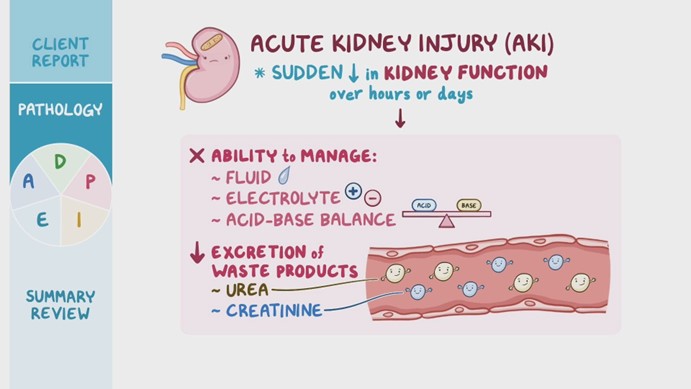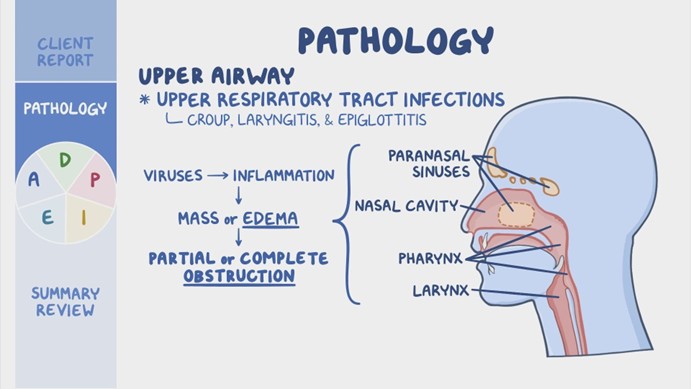A nurse is caring for a client who has acute kidney injury (AKI). Which of the following arterial blood gas values would the nurse expect this client to have?
pH 7.49, HCO3 24, PaCO2 30
pH 7.26, HCO3 24, PaCO2 46
pH 7.26, HCO3 14, PaCO2 30
pH 7.49, HCO3 30, PaCO2 40
The Correct Answer is C
Choice A Reason: This choice is incorrect because it indicates respiratory alkalosis, not AKI. Respiratory alkalosis is a condition in which the lungs eliminate too much carbon dioxide (CO2) from the blood, resulting in a low level of CO2 (PaCO2) and a high level of pH. A normal PaCO2 range is 35 to 45 mm Hg, and a normal pH range is 7.35 to 7.45, so a value of 30 mm Hg and 7.49 indicate respiratory alkalosis.
Choice B Reason: This choice is incorrect because it indicates respiratory acidosis, not AKI. Respiratory acidosis is a condition in which the lungs cannot eliminate enough CO2 from the blood, resulting in a high level of CO2 (PaCO2) and a low level of pH. A value of 46 mm Hg and 7.26 indicate respiratory acidosis.
Choice C Reason: This choice is correct because it indicates metabolic acidosis, which is a common complication of AKI. Metabolic acidosis is a condition in which the body produces too much acid or loses too much base, resulting in a low level of bicarbonate (HCO3) and a low level of pH. A normal HCO3 range is 22 to 26 mEq/L, so a value of 14 mEq/L indicates metabolic acidosis. The low PaCO2 value (30 mm Hg) is due to the respiratory compensation mechanism that tries to restore the acid-base balance by increasing the ventilation and eliminating more CO2.
Choice D Reason: This choice is incorrect because it indicates metabolic alkalosis, not AKI. Metabolic alkalosis is a condition in which the body loses too much acid or gains too much base, resulting in a high level of bicarbonate (HCO3) and a high level of pH. A value of 30 mEq/L and 7.49 indicate metabolic alkalosis.

Nursing Test Bank
Naxlex Comprehensive Predictor Exams
Related Questions
Correct Answer is B
Explanation
Choice A Reason: Infection is a serious complication of burn injuries, but not the priority risk for assessment and intervention. The nurse should monitor the client's wound healing, temperature, white blood cell count, and signs of sepsis, and administer antibiotics as prescribed. However, these measures are secondary to ensuring adequate oxygenation and ventilation.
Choice B Reason: Airway obstruction is the priority risk for assessment and intervention for a client who has burns of the head, neck, and chest. The nurse should assess the client's airway patency, respiratory rate, oxygen saturation, breath sounds, and signs of respiratory distress, such as stridor, wheezes, or cyanosis. The nurse should also provide humidified oxygen, suction secretions, elevate the head of the bed, and prepare for endotracheal intubation if needed. Airway obstruction can occur due to edema, inflammation, or inhalation injury of the upper airway, and can quickly lead to hypoxia, respiratory failure, and death.
Choice C Reason: Paralytic ileus is a potential complication of burn injuries, but not the priority risk for assessment and intervention. The nurse should assess the client's bowel sounds, abdominal distension, nausea, vomiting, and stool output, and administer fluids, electrolytes, and nutritional support as prescribed. However, these measures are secondary to ensuring adequate oxygenation and ventilation.
Choice D Reason: Fluid imbalance is another potential complication of burn injuries, but not the priority risk for assessment and intervention. The nurse should assess the client's fluid status, urine output, vital signs, weight, and serum electrolytes, and administer intravenous fluids as prescribed. However, these measures are secondary to ensuring adequate oxygenation and ventilation.

Correct Answer is C
Explanation
Choice A Reason: This is incorrect because hypertension is a condition of high blood pressure. A client who has hypovolemic shock is more likely to have hypotension, which is a condition of low blood pressure, due to fluid loss and reduced cardiac output.
Choice B Reason: This is incorrect because bradypnea is a condition of slow breathing. A client who has hypovolemic shock is more likely to have tachypnea, which is a condition of fast breathing, due to hypoxia and increased respiratory demand.
Choice C Reason: This is correct because oliguria is a condition of low urine output. A client who has hypovolemic shock may have oliguria due to decreased renal perfusion and activation of the renin-angiotensin-aldosterone system, which causes sodium and water retention.
Choice D reason: This is incorrect because flushing of the skin is a condition of redness and warmth of the skin. A client who has hypovolemic shock may have pallor and coolness of the skin due to vasoconstriction and reduced blood flow.
Whether you are a student looking to ace your exams or a practicing nurse seeking to enhance your expertise , our nursing education contents will empower you with the confidence and competence to make a difference in the lives of patients and become a respected leader in the healthcare field.
Visit Naxlex, invest in your future and unlock endless possibilities with our unparalleled nursing education contents today
Report Wrong Answer on the Current Question
Do you disagree with the answer? If yes, what is your expected answer? Explain.
Kindly be descriptive with the issue you are facing.
